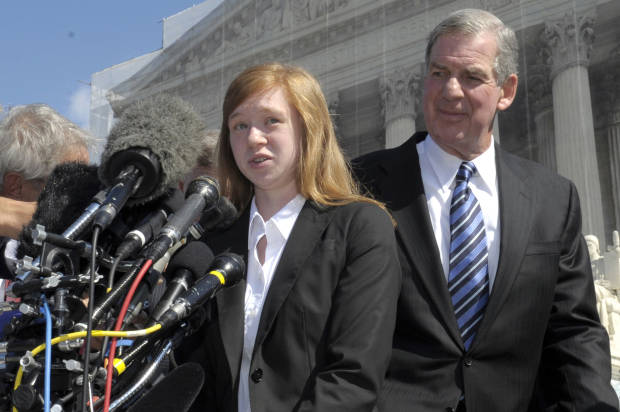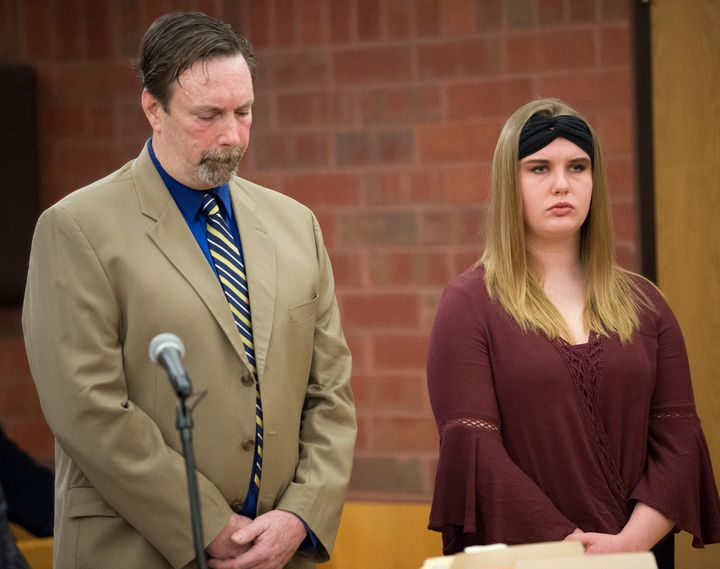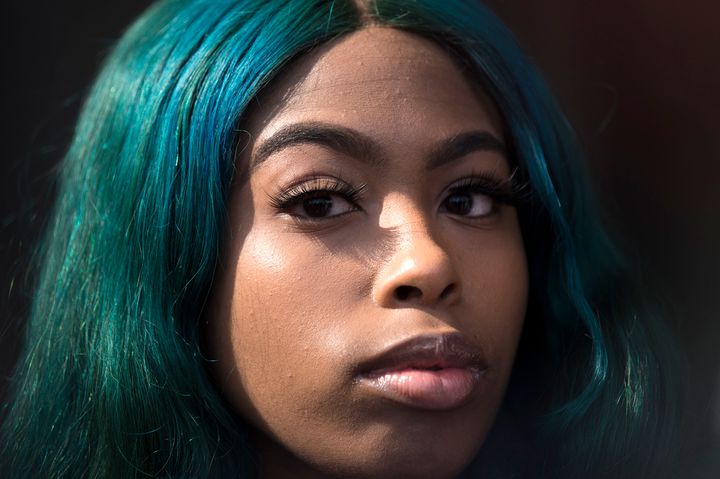source:
Salon
White America’s toxic ignorance: Abigail Fisher, Antonin Scalia and the real privilege that goes unspoken
If affirmative action gives unearned opportunities to one racial group, it is whites who have benefited the most
FILE - In this Oct. 10, 2012, file photo, Abigail Fisher, the Texan involved in the University of Texas affirmative action case, accompanied by her attorney Bert Rein, talks to reporters outside the Supreme Court in Washington. Consideration of race in college admissions is again in line of fire at the Supreme Court on Wednesday, Dec. 9, 2015, for the second time in three years, in the case of Fisher, a white Texas woman who was rejected for admission at the University of Texas. (AP Photo/Susan Walsh)(Credit: AP)
Is Justice Antonin Scalia auditioning for a job as Donald Trump’s ghostwriter?
His recent comments on Fisher v. the University of Texas, a landmark SCOTUS case about the future of affirmative action programs at America’s colleges and universities, would seem to suggest that he is.
During the oral arguments for Fisher v. the University of Texas, Scalia said that:
There are those who contend that it does not benefit African Americans to get them into the University of Texas, where they do not do well, as opposed to having them go to a less-advanced school, a slower-track school where they do well. One of the briefs pointed out that most of the black scientists in this country don’t come from schools like the University of Texas. They come from lesser schools where they do not feel that they’re being pushed ahead in classes that are too fast for them…I’m just not impressed by the fact the University of Texas may have fewer [blacks]. Maybe it ought to have fewer. I don’t think it stands to reason that it’s a good thing for the University of Texas to admit as many blacks as possible.
Scalia’s suggestion that black college students need special remedial schools because they are not able to compete on an “advanced” level is deeply problematic in a number of ways.
It is cringe-worthy because Scalia is channeling the ugly pseudo-scientific racism of influential right-wing texts such as Charles Murray’s “Bell Curve,” which claims that there is some causal connection between a person’s “race” and intelligence.
Scalia’s suggestion that blacks need “special schools” because they are in essence too dumb and lazy to compete with white students is ahistorical
. From their arrival in the United States in chains and bondage in the 17th century through to the post-civil rights era and the 21st century, African-Americans have always placed a very high value on educational success and literacy.
Moreover, there were in fact “special” schools for black people in the United States. These schools were the product of Jim and Jane Crow white supremacy and American apartheid that the Supreme Court struck a blow against with the landmark Brown v. Board of Education decision in 1954. Likewise, historically black colleges and universities were first established in 1837 to ensure that African-Americans would have access to high-quality education because the vast majority of white schools would not admit them. Scalia, as an Italian-American, should know that until the middle of the 20th century, white “ethnics” (Eastern and Southern Europeans like himself; Jews; and other groups) were generally not allowed entry into elite American colleges and universities because they did not come from the right “racial stock” or “class” of white people.
Scalia’s belief that black students belong in special “slower schools” is based on a claim that there is a “mismatch” between the academic preparation of African-American students and their likelihood of success in rigorous post secondary and graduate/professional programs. Scalia speaks with certainty about this hypothesis. In reality, he is relying on a widely discredited and spurious theory
.
Law professor Kimberly West-Falcon, who filed an amicus brief in the Fisher case, makes the point that:
The now decades-old “mismatch” theory that nonwhites from racial groups with lower, on average, SAT scores are harmed by their admission to selective universities is based on the unproven and unprovable assertion that blacks who graduate from selective colleges and universities but do so with relatively lower grades or class rank are harmed by attending such institutions. The research contending to support the mismatch theory rarely acknowledges the fact that such contentions focus almost exclusively on college grades (to the exclusion of college graduation rates).
The inference that Black and Latino high school students are harmed by attending elite educational institutions or would enjoy better life outcomes if they chose less selective institutions is unsupported by empirical research (emphasis added). Instead, social science research has consistently shown that the nonwhite, particularly African American, students supposedly harmed by being “mismatched” at more elite universities are more likely to successfully graduate from the selective universities to which they are admitted and benefit substantially from living life as graduates of more prominent and elite educational institutions (even if their GPAs are lower than either the average white GPA, the GPA predicted by their SAT scores, or their GPA had they attended a less elite institution).
Scalia’s concerns about black students who need “slower schools” because they are in essence stealing opportunities from more “deserving” and “qualified” white students is highly selective and extremely myopic. Scalia is apparently not offended by how colleges and universities across the United States frequently admit
less qualified men in order to maintain gender parity in a given freshman cohort. And given his connections to the Republican Party and movement conservatism, Scalia is likely none too worried about
how the children of legacies and donors (i.e., rich white people who have money) are able to secure preferential admission (and in many cases also graduation) at America’s colleges and universities—when many of whom, like George Bush, would not have been admitted based on test scores, intellectual acuity or merit.
Scalia’s claims that black students may need slower and less advanced schools parallel those of the plaintiff Abigail Fisher in her lawsuit against the University of Texas.
Fisher believes that the University of Texas denied her, a white person, admission by giving “her” spot to an “unqualified” black or brown person. Although Abigail Fisher was a subpar student who did not gain admission under the traditional program (students who graduate in the top 10 percent of their high school class are automatically granted admission to the University of Texas) or the expanded, holistic criterion (the remaining 25 percent of the University of Texas’s class is composed of students whose whole life profile and range of experiences are considered in the review process), she feels that she is a “victim” of “anti-white” bias.
Justice Scalia believes that lazy and dumb black students are not qualified for admission to the University of Texas. As such, they are “taking” slots at the University of Texas and other schools that should be filled with more “qualified” and “deserving” students, i.e., whites (and perhaps Asians). Scalia, like many other conservatives, believes that affirmative action programs are a type of “racial spoils system” that give unfair opportunities and advantages to black and brown people at the expense of whites. Instead of a basic effort to combat past and present discrimination against non-whites (and women), American conservatives have twisted and distorted “affirmative action” into a caricature of “reverse racism” and “anti-white” prejudice.
But if one proceeds from Scalia’s and others’ understanding of affirmative action as a type of system that gives unearned and undeserved opportunities to one racial group at the exclusion of others, it is actually white Americans who have been the biggest—and almost exclusive–beneficiaries of such policies.
From the 17th century to the present, the United States is a society that is structured around the maintenance and protection of white privilege and white advantages across all areas of political, social and economic life. While racism has certainly evolved over time—from a system that was much more direct and personal to one that is institutional—the protection of unearned advantages for white people as a group relative to people of color has remained a constant.
As Philip Rubio documents in his expansive work “A History of Affirmative Action 1619-2000,” being “white” in America is the greatest “affirmative action” plan that a person can benefit from.
There are many examples of a “racial spoils system” for white people in America.
Chattel slavery stole black labor and wealth. Those resources subsidized the growth of white America’s wealth, income and power. Land that was taken from First Nations peoples in genocidal wars was systematically given to white people for free under the various homestead programs.
Historian and political scientist Ira Katznelson’s book “When Affirmative Action Was White” offers a devastating analysis of how white Americans were given the opportunity to accumulate tremendous wealth and other assets by federal programs such as the racially discriminatory post-World War II era FHA and VA home loan programs. President Roosevelt’s New Deal Programs, while extremely popular among black Americans, were also structured to satisfy the political demands of Southern segregationists—which meant that African-Americans were often excluded from programs such as Social Security. In practice, the New Deal and post-World War II federal policies that helped to create the white middle class denied the same opportunities to black and brown Americans.
There is
persistent racial discrimination in the American labor market. Résumés with “black”-sounding names are 50 percent less likely to receive a positive response than those with “white”-sounding names. Moreover, blacks with “high quality” résumés are also called back less often than whites with similar credentials.
Social scientists
have shown that a white job applicant with a felony has the same chance for an interview as a black applicant with no felony. In essence, being a black male with a college degree is the equivalent of being a white criminal. Black Americans and other people of color still encounter racist treatment in promotions and advancement. This is a de facto advantage to whites (especially men) in terms of their ability to reach management and other senior positions because they do not have to worry about competition from other groups.
America’s social networks have high levels of racial segregation.
White Americans are much more likely to be employed, have access to resources and contacts for obtaining work, or to be in a position to offer employment to another person. Blacks and other people of color do not have the same resources. This system of racialized social capital and opportunity structures constitutes a type of “soft” affirmative action that whites can access without having to actively think about it.
Neighborhoods are a key part of the unearned advantages and other types of benefits that white people can access under “soft” affirmative action. African-Americans are discriminated against in the housing market. Even when they have the same credit, income and other resources as whites, blacks and Latinos are either steered away from “white” neighborhoods by real estate agents or shown houses and apartments in less desirable communities. Racially discriminatory lending practices by banks and other financial agencies are part of this process as well. The sum total of these practices is that blacks and Latinos tend to live in neighborhoods that have worse schools, are less safe and have fewer resources generally (such as easy access to mass transit) than whites even controlling for income. In many ways, neighborhoods are destiny because they have a profound impact on a person’s present and future life chances. Ultimately, housing segregation is a central component in America’s affirmative action program for white people.
The phrase “qualified white male” is uncommon in American discourse. Scalia and others on the white right who aim to destroy programs such as affirmative action—and the broader legacy of the civil rights movement in the United States—are unwilling to acknowledge how America’s so-called meritocracy is in fact racialized (as well as gendered) to the
advantage of those who are considered “white” and to the
disadvantage of those stigmatized as “non-white.”
Consequently, white men are almost always assumed–regardless of their backgrounds–to be “qualified” for any job.
This is the gross and ugly contradiction at the heart of the myth of meritocracy: Centuries of white male privilege in the United States from before the Founding through to the present is the exact opposite of reward based on merit, hard work or ability.
In America, black and brown people’s abilities are
a priori judged to be in doubt unless they go to great extremes to prove otherwise. This is true of blue- and white-collar workers. It is also true of Barack Obama, the United States’ first black president. The folk wisdom and life advice that for centuries has been given to many young black people by their elders that “you have to be twice as good to get half as far” as compared to a given white person has largely been proven correct.
Women are also subjected to extra suspicion about their qualifications—especially in male-dominated career fields. Sexism marks women as “unqualified” when compared to men when the two groups are in competition (across most parts of the labor market, although there are exceptions) for the same jobs. There, the male gaze blinds men to asking basic questions about their own professional qualifications. As with whiteness and race, few men ever ask themselves “did I get this job, promotion, or opportunity because I am a man?”
Racism and sexism combine to set an amazingly high barrier and set of challenges for women of color in the American workplace. They are judged to be especially “unqualified” for leadership, management and other roles both because of their gender and “race.” If white men have to take a metaphorical stroll around the block in order to prove that they are “qualified” for a given job, then women of color have to complete a marathon—and finish first while doing so.
Thurgood Marshall, the Supreme Court’s first black justice, spoke to the enduring need for affirmative action programs in his dissent in the landmark Bakke (1978) case:
“For it must be remembered that, during most of the past 200 years, the Constitution as interpreted by this Court did not prohibit the most ingenious and pervasive forms of discrimination against the Negro. Now, when a state acts to remedy the effects of that legacy of discrimination, I cannot believe that this same Constitution stands as a barrier.”
Affirmative action was originally designed to be a modest set of policies that would expand opportunities for people of color who have suffered discrimination and racism in a society built around protecting unearned white advantages.
It is pathetic and tragic that affirmative action, a program that has been under assault by the white right for decades, could finally be brought down by a white-privilege-fueled temper tantrum thrown by a mediocre and entitled white woman who did not get admission to the university of her choice.












